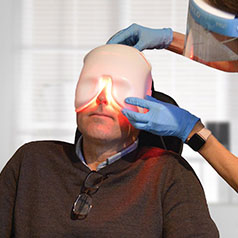The Marco Equinox: How a New, Cutting-Edge Technology Can Help Doctors Develop a Better Approach for Their Dry Eye Cases



An interview with Dr. Glenn Corbin, OD, of Wyomissing Optometric Center
Providing reliable management of dry eye and MGD is a high-potential area of eye care, but without access to the best technology and treatment options, it’s difficult to capitalize on all the opportunity.
One of the instruments that has emerged as a broad approach to the symptoms and underlying causes of dry eye is the Marco Equinox. The Equinox harnesses the power of Low Level Light Therapy (LLLT) in a range of frequencies aimed at resolving dry eye, meibomian gland dysfunction (MGD), Demodex, and chalazia.
We talked with Dr. Glenn Corbin, an Eye-Tech customer and experienced optometrist who specializes in dry eye cases, about his experience using the Equinox in his practice.
Meet Dr. Glenn Corbin
At Wyomissing Optometric Center, a private practice in Berks County, PA with 7 optometrists, Dr. Corbin is the dry eye specialist. As he told us, “We have a specialty dry eye service in our practice, which I direct. All our optometrists refer their dry eye patients to me.”
This gives him a unique insight on the different approaches that are effective in addressing the different conditions that can contribute to a typical “dry eye” case. He talked to us about how the Equinox LLLT device, which he adopted in 2021, works for the dry eye patients he sees every day in his practice:
Why did you add the Equinox to your practice?
Dr. Corbin: I was actually one of the first ODs in the country to adopt the Equinox when it was a new technology to treat MGD. We already had the Mibo Thermaflo, but when I looked at the Equinox and what it could do, that’s what triggered me to make the investment.
What, in your view, does LLLT do differently?
The LLLT mask utilizes medical grade LEDs for light modulation, a photo biomodulation technology that stimulates the production of ATP (Adenosine Triphosphate) by emitting a specific wavelength of light. It is a systematic treatment that works at the cellular level to improve the cells metabolism. Photo biomodulation therapy displaces nitric oxide and allow cellular respiration to take place. The secondary effects of photon absorption are increased ATP production, increase in electron transport, and an increase in nitric oxide circulation.
All of the previous instruments on the market to treat MGD use heat and expression of the glands. I felt that if there was something that could treat the glands differently, which is what the Equinox does, I felt it could augment my therapy. And it has — we’ve had great success with the Low-Level Light Therapy.
What has been the biggest impact of the Equinox since adoption?
Dr. Corbin: It’s probably a bit of both — better and faster outcomes. We’re treating patients who wouldn’t have responded as well with heat and expression by itself. This adds another level to our treatment.
Who performs this therapy in your practice?
Dr. Corbin: It’s tech-driven technology. I have two techs in my practice who are experts at utilizing this technology and doing the expression. I would say that it’s absolutely easy to use and to train techs on.
There are several factors that can cause dry eye. Do you think LLLT is more effective for one over the others?
Dr. Corbin: 85-90% of dry eye patients have meibomian gland disease. That’s the number one cause, and it’s rare to find a patient with any symptoms of dry eye who has perfectly healthy oil glands. For the other diseases — chalazia, Demodex — [LLLT] can also be very effective.
How have patients responded to this therapy?
Dr. Corbin: Dry eye is chronic disease. You can’t cure it, you can only treat it. Patients, when they’re symptomatically improved, they’re going to be very relieved and appreciative. Patients get relief but they need regular treatments to maintain that level of comfortable.
We have a large number of patients who love to come back for additional sessions.
What would you say to a doctor who’s considering adding dry eye treatment (a high-ROI, cash pay service) to their practice?
First, it’s a very easy specialty to add to your practice. You can take a simple specialty like dry eye and be very successful, both clinically and making a living from it, because there’s so much you can offer. We’re making income on the evaluation, we’re making out of pocket income for the meibomian gland treatments, and the follow up appointments are all medically billed.
It’s a small investment with a big return.

How have Drew Tucker and Eye Tech made a difference in your practice?
Dr. Corbin: I’ve been friends with Drew for about 30 years. If there’s something I need to purchase, he’s the first phone call. Just to give you an example, we had the mask for the Equinox run out on us. We had someone scheduled for treatment the next day, so I called Drew. He met me 30 minutes away on the turnpike — that day — and let me use his mask temporarily until a new one came. That’s the kind of relationship Drew and Scott have with their customers.
How have Drew Tucker and Eye Tech made a difference in your practice?
Dr. Corbin: I’ve been friends with Drew for about 30 years. If there’s something I need to purchase, he’s the first phone call. Just to give you an example, we had the mask for the Equinox run out on us. We had someone scheduled for treatment the next day, so I called Drew. He met me 30 minutes away on the turnpike — that day — and let me use his mask temporarily until a new one came. That’s the kind of relationship Drew and Scott have with their customers.


